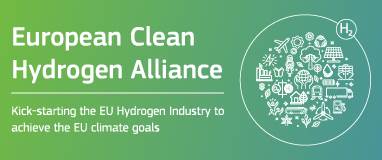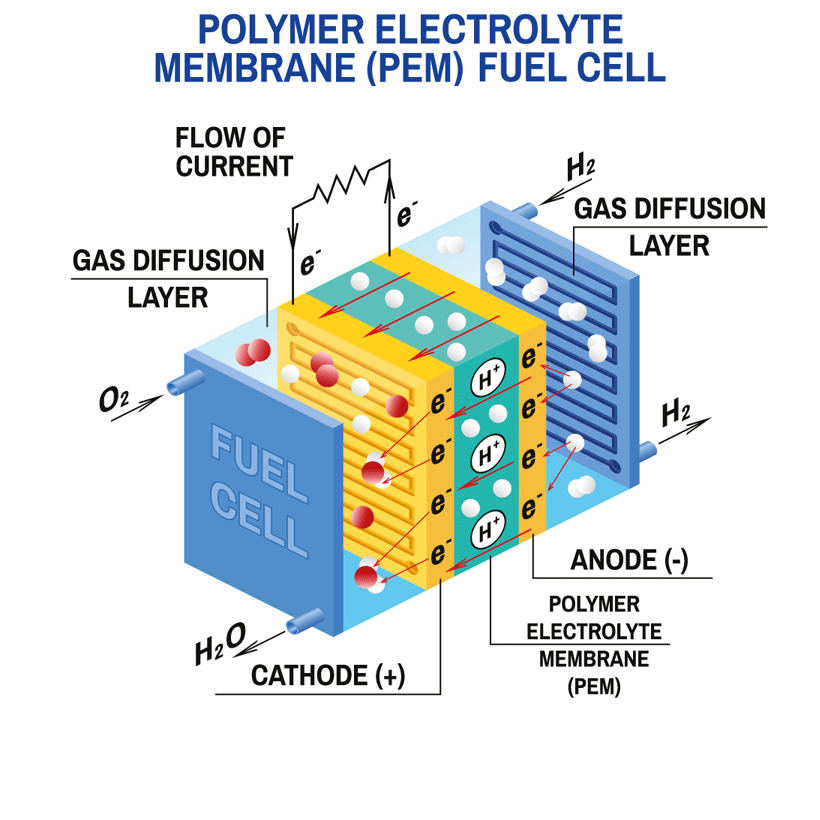Fuel Cells
Fuel cells are a rapidly developing energy conversion technology that will help to decarbonise transport and other areas of life, and compliment battery technology solutions. Offering higher efficiencies than conventional technologies, they also operate quietly. Their modular construction means they can be economically and easily scaled down to small sizes to fit many applications.
These features make fuel cells attractive for a range of potential applications, from combined heat and power (CHP) to distributed power generation to transport and portable power for mobile appliances. Fuel cells are well positioned to drive solutions for a range of markets, from stationary power generation to forklifts and trains.
IPA is a member of the European Clean Hydrogen Alliance and supports the EU’s ambition to become carbon neutral.

Fuel Cells in other applications
Fuel cells are also being designed and tested for stationary applications, for example for individual households as well as large commercial and industrial uses. Fuel cell systems for stationary power generation have been installed worldwide for use in hospitals, hotels, office buildings, schools, utility power plants and even an airport terminal. Prototypes are also underway for residential use. (Source: EU Joint Research Centre)
So far, they have demonstrated excellent fuel efficiency and reliability requiring little maintenance and running quietly. Nonetheless, capital costs remain high and limit their commercial potential at present. Eventually, fuel cells are likely to play a major role in the expanding Combined Heat and Power (CHP) sector.
These installations generate usable heat and power in a single process characterized by a high electrical to heat energy output ratio which makes fuel cells ideal due to their high electrical efficiencies.
Fuel cells are also being tested for use at landfill and wastewater treatment plants where they can reduce emissions and generate power from the methane gas produced there. Other future applications for fuel cells include providing portable power for laptop computers, mobile phones, and other appliances.
What are fuel cells and where are they used?
Fuel cells are electrochemical devices that convert the energy of a chemical reaction directly into electricity, with heat and water as by-products. The fuel and oxidant (oxygen or air) are supplied externally, enabling them to continue operating as long as they are fed. So, unlike batteries, they never "run out".
Hydrogen, when used in a fuel cell, generates power electrochemically with only water as the by-product. This means that fuel cells can create power without releasing any harmful emissions or particulates.
Platinum and ruthenium play a large role in this technology. Platinum is the catalyst which converts hydrogen and oxygen to heat, water, and electricity. Palladium will likely also play a role in the fuel cell, but it is unknown yet how big.
Many believe that the fuel cell engine, comprising a fuel processor, fuel cell stack and power conditioner, will ultimately take the place of the internal combustion engine as the dominant technology for vehicles from cars to trains.
How does a fuel cell work?
A fuel cell consists of two electrodes sandwiched around an electrolyte. Oxygen passes over one electrode and hydrogen over the other, generating electricity, water and heat.
At the anode, H2 is separated into hydrogen ions and electrons, a process assisted by a catalyst usually comprising Platinum Group Metals. The electrons travel through an external circuit, generating the required power. The ions pass through the electrolyte to the cathode where, assisted by another catalyst, they join with oxygen atoms to produce water.
Oxygen is sourced through the air. Hydrogen is sourced from either:
- several conventional hydrocarbon fuels such as natural gas, methanol/methane, gasoline, etc.
- or from renewable energy sources such as solar, wind, electrolysis of water, biomass, etc.
A fuel cell system including a "fuel reformer" to extract hydrogen from a hydrocarbon produces minimal NOx and less CO2 than conventional combustion technology due to increased efficiency.
If hydrogen from renewable sources is used, then there is no carbon in the chain and harmful emissions are practically zero.
The only exhaust of a fuel cell is water - pure water.






